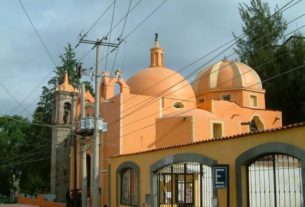A Mexico book by Marilyn P. Davis
Mexican immigration into the U.S., according to the author, represents “the greatest migration of people in the history of humanity.” She estimates that some 5 million legal Mexican immigrants reside in the U.S. plus there’s a further 2 million illegal immigrants also in the country. Those numbers actually seem low. They were produced in the late ’80’s and, presumably, are higher now although really accurate numbers are hard to obtain. But there are other indicators. It’s estimated, for example, that the amount of money that illegals return to their families now exceeds Mexico’s income from tourism. Indeed, it’s believed that 20 per cent of the banks in Jalisco would fold if not for the deposits sent home from the U.S.
Mexican immigration into the U.S., according to the author, represents “the greatest migration of people in the history of humanity.” She estimates that some 5 million legal Mexican immigrants reside in the U.S. plus there’s a further 2 million illegal immigrants also in the country.
As the author says: “It is difficult to find a family in the pueblos of central Mexico that doesn’t have members who are, have been, or are soon going to be in the United States. The Mexican film industry provides another interesting indicator. In recent years, 35 per cent of all production has been devoted to movies with an illegal immigrant theme.”
She continues: “First, bringing people across is a major service industry with juicy profits for both countries. And the simple fact is that everyone who wants to cross does. Of those who cross, most will stay for a short time to see what it is all about, make a little money, and return to their pueblos. Some will return cyclically, generally timed to the harvest season. A few, particularly those successful in large cities, may remain for many years, perhaps permanently.”
In fairness, Ms. Davis reminds us that not all these immigrants – at least among the legal ones – are cleaners and pickers and farm workers. She interviewed architects, musicians, businessmen, scientists and others engaged in intellectual work. Also, I found it curious that quite a few of these people send their children to private schools in Mexican cities, rather than to U.S. schools.
The comments of many of these people are interesting when they compare Mexico with the United States. They all seem to make a conscious effort to stay uniquely Mexican. To paraphrase the old saying: You can take the Mexican out of Mexico, but you can’t take Mexico out of him or her.
As an immigrant myself – from England to Canada many, many years ago – I can relate somewhat to the experience. But having gone to Toronto – one of the most emigrated-to cities in the world – I can’t recall ever longing for my former culture in the way that Mexicans cling to theirs. Nor did I get the impression that all those Brits, Italians, Germans, Dutchmen, Greeks, Chinese and Pakistanis in Canada were that intent on keeping one foot in their former world.
Perhaps one reason is the prejudice against Mexicans among so many Americans. As one immigrant recalls: “When I was growing up in San Antonio I remember kids telling me, ‘Don’t tell my parents that you’re Mexican, otherwise you can’t come over,’ or ‘Don’t speak Spanish in our house because we’re not allowed to hang out with Mexicans.'” Ironically, San Antonio is now one of the most Hispanic cities in the country.
Says one immigrant: “I love Mexico. I go every six months to get away from the almighty dollar and the hustle, bustle. We constantly kill ourselves. We say I’ve got to do this, I’ve got to do that, I’ve got to be at the bank at nine o’clock. We’re just pressured and keeping our bodies tense.” And another: “Mexico was so much more a country of smells and sounds; the United States was very clean and sterile.” Yet another: “Mexican culture has a certain wisdom I appreciate. My grandfather is Don Chema. You don’t just call yourself by the title of Don. I can’t be Don; I’m not old enough, I’m not wise enough. Unlike American culture, Mexicans value age. There is respect for someone for simply being older. They don’t feel bad if they are ninety, because they are still respected. Here people are channeled out of the job market when they’re too old and sent off to retirement communities.”
It’s well known that crossing the border is not without its risks and problems. “The worst robbers are the Mexican police. For a Mexican the border is worse when you’re returning. If you’ve been in the U.S. without papers, the Mexican border police will take everything you have to let you back in. They know you can’t turn around, and if they won’t let you go forward, well, where can you go?”
But despite the problems what emerges most strongly from these pages is a portrait of a rather attractive people – caring and courteous, devoted to their families yet determined to find a better life. One wishes them the best of luck.
After saying all that I have to admit to some embarrassment over this book. After reading it I looked in Amazon.com just to see what other readers thought of it. To my dismay, I found that it’s out of print. However, it should be available in libraries or used bookstores. Also, I discovered that the author herself has some copies available in both paperback and hardcover. Her e-mail address in California is [email protected].
In my humble O: Go to your computer right now and order a copy. This one’s a winner.
Available from Amazon Books: Paperback
 Mexican Voices/American Dreams
Mexican Voices/American Dreams
An oral history of Mexican immigration to the United States
By Marilyn P. Davis
Henry Holt, 1990. Hardcover and paperback.

